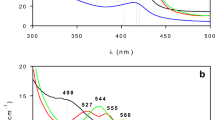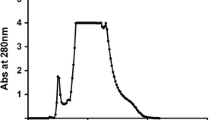Abstract
The ability of poly(ethylene glycol) (PEG) to protect enzymatic peroxidase activity was determined for horseradish peroxidase (HRP), versatile peroxidase (VP), commercial Coprinus peroxidase (BP), and chloroperoxidase (CPO). The operational stability measured as the total turnover number was determined for the four peroxidases. The presence of PEG significantly increased the operational stability of VP and HRP up to 123 and 195 %, respectively, and dramatically increased the total turnover number of BP up to 597 %. Chloroperoxidase was not protected by PEG, which may be due to the different oxidation mechanism, in which the oxidation is mediated by hypochlorous ion instead of free radicals as in the other peroxidases. The presence of PEG does not protect the enzyme when incubated only in the presence of H2O2 without reducing substrate. The catalytic constants (k cat) are insensitive to the presence of PEG, suggesting that the protection mechanism is not due to a competition between the PEG and the substrate as electron donors. On the other hand, PEG showed to have a significant antioxidant capacity. Thus, we conclude that the protection mechanism for peroxidases of PEG is based in its antioxidant capacity with which it is able scavenge or drain radicals that are harmful to the protein.




Similar content being viewed by others
References
Linossier, G. (1898). Contribution à l’étude des ferments oxidants. Sür la peroxidase du pups. Comtes Rendues de la Societé de Biologie, Paris, 50, 373–375.
Valderrama, B., Ayala, M., & Vazquez-Duhalt, R. (2012). Suicide inactivation of peroxidases and the challenge of engineering more robust enzymes. Chemistry & Biology, 9, 555–565.
Ayala, M., Pickard, M. A., & Vazquez-Duhalt, R. (2008). Fungal enzymes for environmental purposes: a molecular biology challenge. Journal of Molecular Microbiology and Biotechnology, 15, 172–180.
Miyazaki, C., & Takahashiemail, H. (2001). Engineering of the H2O2-binding pocket region of a recombinant manganese peroxidase to be resistant to H2O2. FEBS Letters, 509, 111–114.
Miyazaki-Imamura, C., Oohira, K., Kitagawa, R., Nakano, H., Yamane, T., & Takahashi, H. (2003). Improvement of H2O2 stability of manganese peroxidase by combinatorial mutagenesis and high-throughput screening using in vitro expression with protein disulide isomerase. Protein Engineering, 16, 423–428.
Valderrama, B., Garcia-Arellano, H., Giansanti, S., Baratto, M. C., Pogni, R., & Vazquez-Duhalt, R. (2006). Oxidative stabilization of iso-1-cytochrome c by redox-inspired protein engineering. FASEB Journal, 20, 1233–1235.
Cherry, J. R., Lamsa, M. H., Schneider, P., Vind, J., Svendsen, A., Jones, A., & Pedersen, A. H. (1999). Directed evolution of a fungal peroxidase. Nature Biotechnology, 17, 379–384.
Vidal-Limón, A., Águila, S., Ayala, M., Batista, C. V., & Vazquez-Duhalt, R. (2013). Peroxidase activity stabilization of cytochrome P450BM3 by rational analysis of intramolecular electron transfer. Journal of Inorganic Biochemistry, 122, 18–26.
Nakamoto, S., & Machida, M. (1992). Phenol removal from aqueous solutions by peroxidase-catalyzed reactions using additives. Water Research, 26, 49–54.
Klibanov, A. M., Tu, T., & Scott, K. P. (1983). Peroxidase catalyzed removal of phenols from coal-conversion waste waters. Science, 221, 259–261.
Mao, L., Luo, S., Huang, Q., & Lu, J. (2013). Horseradish peroxidase inactivation: heme destruction and influence of polyethylene glycol. Scientific Reports, 3, 3126.
Wu, Y., Taylor, K. E., Biswas, N., & Bewtra, J. K. (1997). Comparison of additives in the removal of phenolic compounds by peroxidase-catalyzed polymerization. Water Research, 31, 2699–2704.
Quintanilla-Guerrero, F., Duarte-Vázquez, M. A., García-Almendarez, B. E., Tinoco, R., Vazquez-Duhalt, R., & Regalado, C. (2008). Polyethylene glycol improves phenol removal by immobilized turnip peroxidase. Bioresource Technology, 99, 8605–8611.
Wu, Y., Taylor, K. E., Biswas, N., & Bewtra, J. K. (1998). A model for the protective effect of additives on the activity of horseradish peroxidase in the removal of phenol. Enzyme and Microbial Technology, 22, 315–322.
Manoj, K. M., & Hager, L. P. (2008). Chloroperoxidase, a Janus enzyme. Biochemistry, 47, 2997–3003.
Spreti, N., Germani, R., Incani, A., & Savelli, G. (2004). Stabilization of chloroperoxidase by polyethylene glycols in aqueous media: kinetic studies and synthetic applications. Biotechnology Progress, 20, 96–101.
Zhi, L., Jiang, Y., Wang, Y., Hu, M., Li, S., & Ma, Y. (2007). Effects of additives on the thermostability of chloroperoxidase. Biotechnology Progress, 23, 729–733.
Narayanan, R., Zhu, G., & Wang, P. (2007). Stabilization of interface-binding chloroperoxidase for interfacial biotransformation. Journal of Biotechnology, 128, 86–92.
Wang, Y., Vazquez-Duhalt, R., & Pickard, M. A. (2003). Manganese-lignin peroxidase hybrid from Bjerkandera adusta oxidizes polycyclic aromatic hydrocarbons more actively in the absence of manganese. Canadian Journal of Microbiology, 49, 675–682.
Pickard, M. A., Kadima, T. A., & Carmichael, R. D. (1991). Chloroperoxidase, a peroxidase with potential. Journal of Industrial Microbiology, 7, 235–242.
Marklund, S., & Marklund, G. (1974). Involvement of the superoxide anion radical in the Autoxidation of pyrogallol and a convenient assay for superoxide dismutase. European Journal of Biochemistry, 47, 469–474.
Kim, S. J., Joo, J. C., Kim, H. S., Kwon, I., Song, B. K., Yoo, Y. J., & Kim, Y. H. (2014). Development of the radical-stable Coprinus cinerus peroxidase (CiP) by blocking the radical attack. Journal of Biotechnology, 189, 78–85.
Manoj, K. M. (2006). Chlorinations catalyzed by chloroperoxidase occur via diffusible intermediate(s) and the reaction components play multiple roles in the overall process. Biochimica Biophysica Acta, 1764, 1325–1339.
White, C. W., Jackson, J. H., Abuchowski, A., Kazo, G. M., Mimmack, R. F., Berger, E. M., Freeman, B. A., McCord, J. M., & Repine, J. E. (1989). Polyethylene glycol-attached antioxidant enzymes decrease pulmonary oxygen toxicity in rats. Journal of Applied Physiology, 66, 584–590.
Luo, J., Borgens, R., & Shi, R. (2002). Polyethylene glycol immediately repairs neuronal membranes and inhibits free radical production after acute spinal cord injury. Journal of Neurochemistry, 83, 471–480.
Ayala, M., Roman, R., & Vazquez-Duhalt, R. (2007). A catalytic approach to estimate the redox potential of heme-peroxidases. Biochemical Biophysical Research Communications, 357, 804–808.
Hondal, K., Maeda, Y., Sasakawa, S., Ohno, H., & Tsuchida, E. (1981). The components contained in polyethylene glycol of comercial grade (PEG-6000) as cell fusogen. Biochemical Biophysical Research Communications, 101, 165–171.
Marks, J. D., Pan, C.-Y., Brushell, T., Cromie, W., & Lee, R. C. (2001). Amphiphilic, tri-block copolymers provide potent membrane-targeted neuroprotection. FASEB Journal, 15, 1107–1109.
Almkvist, G., & Persson, I. (2008). Fenton-induced degradation of polyethylene glycol and oak holocellulose. A model experiment in comparaison to changes observed in conserved waterlogged wood. Holzforschung, 62, 704–708.
Chen, S.-X., & Schopfer, P. (1999). Hydroxyl-radical production in physiological reactions. A novel function of peroxidase. European Journal of Biochemistry, 260, 726–735.
Montellano, P. R. (2010). Catalytic mechanisms of heme peroxidases. In E. Torres & M. Ayala (Eds.), Biocatalysis based on heme peroxidases: Peroxidases as potential industrial biocatalysts (pp. 79–107). Berlin: Springer-Verlag. Ch. 5.
Busi, E., Howes, B. D., Pogni, R., Basosi, R., Tinoco, R., & Vazquez-Duhalt, R. (2000). Modified cytochrome c/H2O2 system: spectroscopic EPR investigation of the biocatalytic behaviour. Journal of Molecular Catalysis B: Enzymatic, 9, 39–48.
Wu, J., Zhao, C., Lin, W., Hu, R., Wang, Q., Chen, H., Li, L., Chen, J., & Zheng, J. (2014). Binding characteristics between polyethylene glycol (PEG) and proteins in aqueous solution. Journal of Material Chemistry B, 2, 2983–2992.
Acknowledgments
The authors wish to thank Dr. Katrin Quester for her expert technical assistance. K. Juarez-Moreno was awarded with a DGAPA-UNAM postdoctoral fellowship, and this work was funded by the National Council of Science and Technology of Mexico (CONACyT -165633).
Author information
Authors and Affiliations
Corresponding author
Rights and permissions
About this article
Cite this article
Juarez-Moreno, K., Ayala, M. & Vazquez-Duhalt, R. Antioxidant Capacity of Poly(Ethylene Glycol) (PEG) as Protection Mechanism Against Hydrogen Peroxide Inactivation of Peroxidases. Appl Biochem Biotechnol 177, 1364–1373 (2015). https://doi.org/10.1007/s12010-015-1820-y
Received:
Accepted:
Published:
Issue Date:
DOI: https://doi.org/10.1007/s12010-015-1820-y




